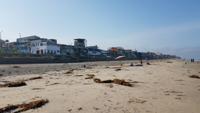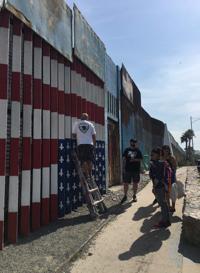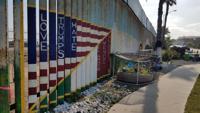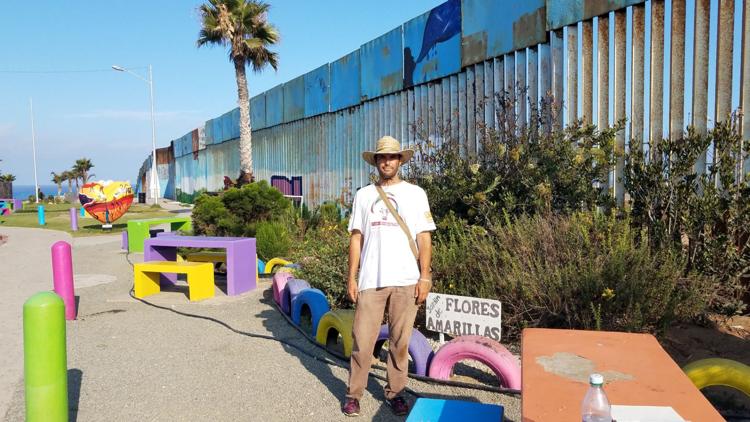When I arrived at Las Playas de Tijuana (the Tijuana beach) in the early morning Aug. 1, members of a boys soccer team were looking through the steel beams of the international border fence, talking among themselves. Meanwhile, on the U.S. side, four dune buggies approached the fence.
I’ve recently made it a habit, when visiting my parents in San Diego, to take a day to go over the border into Tijuana, Mexico. This was my third such trip. There’s always something of interest to me, connecting art and politics, connecting to stories that I’ve followed and/or written about in Indianapolis.
The dune buggies swerved around and then stopped at a beachside dune. I saw the men get out of the vehicles, which I assumed were Border Patrol. One of the men lifted his binoculars and looked towards the fence.
Just a few minutes earlier I had seen one of the distinctive white, green-striped Border Patrol SUVs parked farther inland, not far from the secondary fence installed on the U.S. side.
The soccer team coach blew his whistle. Then the boys started running down the beach.

You could never confuse Las Playas with, say, the expensive Mission Beach beachfront in San Diego, 10 miles to the north. The buildings above the Tijuana beach boardwalk, for one thing, look like they could use some love and/or major repair. But one thing you can say about Las Playas is that it has plenty of heart.
Or, should I say, hearts. I’m referring to the painted fiberglass heart sculptures—each hand-painted by different artists—planted along the border fence and the well-maintained boardwalk. This public art project was connected with the Mexican Teletón, that raises funds for children’s rehabilitation centers, are just one thing that makes this beach unique. (The Teletón ’s symbol is a heart.)
The other remarkable thing about this beach, of course, is the border fence that juts out 91 meters into the Pacific Ocean.
But the border fence itself has also been turned into a public art project. Some of it started as the work of individual artists, like Mexican-born, San Francisco-based artist Ana Teresa Fernández who painted a 50-ft.-long section stretch of fence sky blue in a project called “Erasing the Border.” In a certain light, at certain times of the day, it looks like you can just walk right through the fence.
Also on view is an American flag depicted upside down, a symbol of distress, with crosses for stars. It was painted by Mexican-born U.S. military veterans who have been deported for infractions large and small—from drug felonies to failure to appear for a court date. (Military service does not guarantee U.S. citizenship to the foreign-born, but it can smooth the path to citizenship.)

The “distress” flag was first painted on the fence posts five years ago, and it has been repainted a number of times by the veterans themselves to raise awareness of their predicament.
The Border Patrol started reporting about receiving complaints about the flag after Trump visited wall prototypes on the U.S. side of the border in March. All things considered, the timing of these complaints doesn’t seem like much of a coincidence.
U.S. Customs and Border Protection is currently reviewing the flag painting, according to a May 16, 2018 article in The Washington Post. Presumably a decision whether to remove it or whether to let it be is forthcoming. Presumably, Border Patrol has the authority to remove the mural since the fence is U.S government property.
But the U.S. government has yet to express an opinion on what is arguably the biggest art projects in the world—under the directorship of Tijuana-based artist Enrique Chiu. It begins along the beach and then stretches two kilometers, following the border fence inland into Tijuana and involves hundreds of artists all painting under Chiu’s direction, but with considerable artistic freedom for each participant. It is called «The Brotherhood Mural.»

(On this trip, I met up with Chiu. And in a forthcoming blog I will be talking him at his studio.)
Another interesting and imaginative feature to be found at border fence are the small gardens planted with native plants, along the fence up a little way from the beach. Several of the gardens, straddling the fence, were lined by semicircles of tires sunk halfway into the ground lengthwise, painted in various pastels.
I was checking out the native plants when a man came by wearing a “Friends of Friendship Park” T-shirt and a straw hat walked by. We nodded at one another.
A few minutes later I saw that he was watering the garden plots along the fence, plots that are designed to be mirrored on the other side of the border fence.
So I walked up to him, introduced myself, and asked him what he was doing.
As it turns out, the man—Dan Watman—is coordinator and for the Bi-national Friendship Garden of Native Plants inside Friendship Park.
The intent of the park was to have maintained garden plots that extended across the border, on both sides of the fence.
“That’s the way it was when we founded it back in 2007,” he told me. “And for a few years after that. But in 2009 they put in this secondary wall here and from that point on things got a lot more restrictive on the US side. So they still give us permission to go in on the U.S. side but it’s still very restrictive. On the Mexican side of course it’s wide open. And on the Mexican side we’re able to do a lot of workshops and things like that even if we can’t convince Border Patrol to let people in on the U.S. side.»
Friendship Park also affords Americans and Mexicans the chance to walk up to the fence and talk to one another through the fence and talk with one another, but said access has also become increasingly-restricted.
The organization that the U.S.-born Watman is part of, Friends of Friendship Park, doesn’t have official nonprofit status but it operates on both sides of the border.
“It’s a coalition of Human rights organizations environmental organizations and individuals who want to advocate for more access to the park,” he said.
I didn’t bother asking Watman, who is also a part-time Spanish teacher currently living in Tijuana, about his opinions on Trump.
But I didn’t encounter anybody wearing anti-Trump politics on their shirtsleeves, as it were.
That is to say, nowhere in the park were there any anti-Trump signs—unless you consider the “Love Trumps Hate” painted along with a bi-national flag on the border fence posts, as being derogatory somehow.

I told Watman that it seemed as if the M.O. of the activity in Friendship Park and on the fence was to keep things positive. He agreed.
“It’s kind of like the garden and the painting and all the activities go on in Friendship Park are kind of like a way of creating an oasis of hope and friendliness in the middle of a really draconian US policy at the border,” Watman said.


